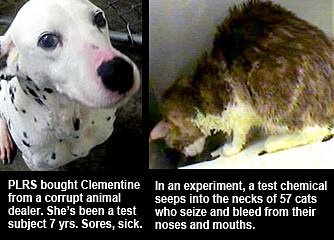Filed under: AR Alert, AR News, News, Victory! | Tags: Animal Testing and Vivisection, PETA, PLRS Lab, Professional Laboratory and Research Services
Professional Laboratory and Research Services Undercover Investigation
Investigation Report from PETA
Investigation Victory: Just one week after PETA released the results of its shocking undercover investigation of North Carolina–based contract animal testing facility Professional Laboratory and Research Services, Inc. (PLRS) and filed a complaint with the U.S. Department of Agriculture (USDA), PLRS is surrendering nearly 200 dogs and dozens of cats and shutting its doors for good. This is a monumental victory and the first time that a laboratory has been forced to surrender animals and close under pressure on the heels of a PETA investigation and while facing a formal USDA investigation.

For nine months, a PETA investigator worked undercover inside the filthy, deafeningly loud kennels of Professional Laboratory and Research Services, Inc. (PLRS). Inconspicuously tucked away in rural North Carolina, PLRS takes money from huge pharmaceutical companies to test insecticides and other chemicals used in companion animal products. Bayer, Eli Lilly, Novartis, Schering-Plough (now Merck), Sergeant’s, Wellmark, and Merial, the maker of Frontline flea and tick products, are some of the corporations that have paid PLRS to force-feed experimental compounds to dogs and cats and smear chemicals onto the animals’ skin.
PETA’s investigator found that toxicity tests were just part of what the animals endured. Laboratory workers appeared to despise the animals in their care—they yelled and cursed at cowering dogs and cats, calling them “asshole,” “motherfuckers,” and “bitch”; used pressure hoses to spray water—as well as bleach and other harsh chemicals—on them; and dragged dogs through the facility who were too frightened to walk.
Video evidence shows that terrified cats were pulled from cages by the scruff of the neck while workers screamed in their faces and that a cat was viciously slammed into the metal door of a cage. One worker grabbed a cat and pushed him against a chain-link fence. When the cat fearfully clutched at the fencing with his claws, the worker jerked him off the fencing, saying she hoped that the cat’s nails had been ripped out.
Dogs at PLRS may spend years in cages, either to be used repeatedly in tests or to be kept infested with worms for some future study. They are just like the dogs we share our homes with, but they live day in, day out without exercise or enrichment, companionship, a scratch behind the ears, or even a kind word from the only people they ever see.
Many dogs had raw, oozing sores from being forced to live constantly on wet concrete, often in pools of their own urine and waste. Workers didn’t even move the dogs when they pressure-sprayed the runs, frightening the animals; soaking them with water, bleach, and soap; and exposing already painful sores to harsh, irritating chemicals.
PLRS didn’t bother to keep a veterinarian on staff. Instead, it chose to bring its primary veterinarian in for only one hour most weeks. Animals endured bloody feces, worm infestations, oozing sores, abscessed teeth, hematomas, and pus- and blood-filled infections without receiving adequate veterinary examinations and treatment. Sometimes, the conditions were ineffectively handled by workers who had no credentials or veterinary training.
After a supervisor gave one dog an anesthetic that was past its expiration date (and likely administered too little of it), the supervisor pulled out one of the animal’s teeth with a pair of pliers. The dog trembled and twitched in apparent pain, and the supervisor continued with the procedure despite the dog’s obvious reaction. Workers repeatedly cut into one dog’s tender, blood-filled ear, draining blood and pus but never treating the underlying cause of the dog’s suffering and apparently causing the ear to become infected.
Dogs were intentionally subjected to worm infestations for tests, but conditions were so sloppy that dogs who weren’t supposed to be part of the study also became infested and were then left untreated.
In one test commissioned by a corporation whose products are sold in grocery and drug stores nationwide, a chemical was applied to the necks of 57 cats. The cats immediately suffered seizures, foamed at the mouth, lost vision, and bled from their noses. Despite this, the substance was put on the cats a second time the very same day.
To cut costs, PLRS killed nearly 100 cats, rabbits, and dogs. The company had decided that some of these animals’ six daily cups of food were too expensive.
Federal oversight of horrendous facilities such as PLRS is virtually nonexistent. In preparation for a U.S. Department of Agriculture (USDA) inspector’s annual visit, which PLRS staff knew to expect in June or July, PLRS employees painted over the rusty surfaces that the USDA had warned them about the previous year and reported that ailing animals had conditions that might merit veterinary care—which the facility’s attending veterinarian reportedly advised she would not provide—so that PLRS staff would be “covered” from blame should the inspector inquire about the animals’ condition. The inspector’s 2010 visit to PLRS, which housed approximately 400 animals at the time, lasted two hours and 15 minutes.
PETA has filed complaints with federal and state agencies, the Occupational Safety and Health Administration, and local law-enforcement authorities.
UPDATE: North Carolina Lab Animals Saved! Charge Their Abusers
They are safe. Nearly 200 dogs and 54 cats — tortured by lab staff who kicked, slammed and dragged them — now have a chance to heal.
9/18/10 – KINSHIP CIRCLE
Professional Laboratory and Research Services Inc. (PLRS) in Corapeake, North Carolina was forced to close and surrender its “test subjects” after a PETA investigation uncovered diseased and wounded dogs, cats and rabbits. Over 9 months, PETA’s investigator recorded staff brutally mishandling terrified animals. One worker used pliers to wrench teeth from a frantic dog. Another tried to pull out a cat’s claws.
PLRS closure is a portal to the routine abuse that occurs in ALL labs. Animal experimentation itself causes creatures to convulse, bleed, stagger, die. Imagine being overdosed with poison or cut apart while restrained. There isn’t one animal experiment today that couldn’t be replaced by non-animal research tools. But animals come cheap and old habits die hard.
ALL PHOTOS show staff at Beagles to the Rescue (VA) taking in abused dogs from the now shuttered PLRS research lab. SEE NEWS VIDEO.
But for PLRS animals, there is hope. Animal Welfare Institute (AWI) and Humane Society of the U.S. (HSUS) — working with about 12 regional shelters/rescues — have taken in the lab’s surviving dogs and cats. At this time, Kinship Circle does not know the fate of any rabbits. We do know that PLRS killed rabbits upon conclusion of experiments.
Shelters & Rescues with dogs and cats from PLRS:
** Most animals will be in quarantine and rehab before available for adoption/foster.
** Contact shelters below to inquire about animals rescued from PLRS.
** Check shelter websites for updates, as information is limited right now.
** As of 9/18/10: No mention of where rescued cats went, only the dogs.
Associated Humane Societies (NJ) — 973-824-7080
http://www.ahscares.org/
Beagles to the Rescue (VA) — 757-204-4411 (4 beagle girls)
http://www.beaglestotherescue.org/home.cfm
Carteret County Humane Society (NC) — 252-247-7744
http://www.cchsshelter.com/
Elizabeth City SPCA (VA) — 757-344-3033 (15 PLRS animals)
To adopt or foster these animals, contact Sabrenna or John at 252-338-5222
http://www.spcaofnenc.org/
Guilford County Animal Shelter — 336-297-5020
http://www.adoptshelterpets.org/
In Dogs We Trust (FL) — 561-400-7732 (18 PLRS dogs)
http://www.floridadogadoption.com/
Nicole@trustthedog.com
Norfolk SPCA (VA) — 757-622-3319 (38 PLRS dogs)
http://www.norfolkspca.com/
Triangle Beach Rescue (NC) — info@tribeagles.org
http://www.tribeagles.org
Virginia Beach SPCA (VA) — 757-427-0070
http://vbspca.com/modules/vbspcainfo/category.php?categoryid=1
Wake County Animal Control/Adopt. Ctr. (NC) — 919-212-7387
http://www.wakegov.com/pets/shelter/default.htm
animalcontrol@wakegov.com
Wake County SPCA (NC) — 919-772-2326
http://www.spcawake.org/site/PageServer
Washington Animal Rescue League (DC) — 202-726-2556
http://www.warl.org
adopt@warl.org
http://www.ahscares.org/
http://www.beaglestotherescue.org/home.cfm
http://www.cchsshelter.com/
To adopt or foster these animals, contact Sabrenna or John at 252-338-5222
http://www.spcaofnenc.org/
http://www.adoptshelterpets.org/
http://www.floridadogadoption.com/
Nicole@trustthedog.com
http://www.norfolkspca.com/
http://www.tribeagles.org
http://vbspca.com/modules/vbspcainfo/category.php?categoryid=1
http://www.wakegov.com/pets/shelter/default.htm
animalcontrol@wakegov.com
http://www.spcawake.org/site/PageServer
http://www.warl.org
adopt@warl.org
Filed under: Animal Rights Issue, Animal Rights News, Announcement, AR Alert, Local Events, News, Petition/Letter Writing, Use Your Voice! | Tags: NASA to Radiate Monkeys, NASA's Monkey Experiments, PCRM, PETA, primate testing, Squirrel Monkeys

NASA will be exposing 18 to 28 squirrel monkeys to low doses of radiation to understand the effects of long distance space travel.
With NASA’s conference in DC this week, we have to mention…
NASA’s Plan to Radiate Squirrel Monkeys
For the first time in decades NASA is stepping up its space radiation program to use monkeys as the subjects of its studies. NASA will expose 18 to 28 Squirrel monkeys to radiation and periodically test them to gauge how exposure affects performance in a variety of learned tasks. This research will violate NASA’s own stated principles regarding animal ethics. According to the Physician’s Committee for Responsible Medicine (PCRM), “that policy, established in 1996, asserts that ‘the minimization of distress, pain and suffering is a moral imperative’ and emphasizes that experimenters must weigh the burdens of animal subjects against potential societal benefits.”
from PETA
NASA has recently announced a shocking plan to spend $1.75 million of taxpayer money to fund an experiment in which up to 30 squirrel monkeys will be blasted with a massive dose of radiation equivalent to what a human would experience during three years in outer space. These monkeys will then live the rest of their lives in cages and be forced to endure years of behavioral tests to measure the inevitable devastation that the radiation causes to their brains and bodies, which would likely include brain damage, skin inflammation, blindness, various types of cancer, including brain tumors, and premature death.
Like all animal experiments, physiological and anatomical differences between species make it impossible to generate data that can be reliably applied to humans. And the large single dose of radiation that the monkeys will be exposed to in a matter of minutes is nothing like the low levels of radiation that human astronauts would be exposed to over extended periods of time in space. The only guarantee that comes with these experiments is that sensitive and intelligent monkeys will be caused immeasurable harm.
from Animal-rights activists vs. NASA over plan to radiate monkeys
Science Takes a Giant Leap Backward
Kathleen Conlee, director of program management for animal research at the Humane Society, worked with monkeys used in radiation experiments. She said the effects on the animals were devastating.
“Their teeth fell out. They self-mutilated,” she said.
Conlee said NASA is disregarding its own guidelines. Humane Society Executive Vice President Andrew Rowan “chaired a committee that was convened by NASA itself,” Conlee said. “And they came out with a report on animal use. This use goes against many of the principles in that report.”
Ineffective
PETA believes the experiment is not just harmful but useless.
The monkeys will receive vastly different quantities of radiation than humans would receive while traveling through space, Justin Goodman, a research supervisor at PETA and a protester said.
“The current experiment that’s being planned is going to expose monkeys to one massive dose of radiation,” Goodman said.
“When humans go into space, they’re going to be exposed to a low level of radiation.”
Conlee said other primates often don’t react as humans do.
“Just because you’re using a primate doesn’t mean that you’re going to get the results a human would,” Conlee said.
Conlee said that similar experiments have already been conducted on many animals, including primates.
“There have been literally hundreds of government-funded radiation experiments since the ’50s,” she said. “This data is already out there.”
Waste of money
The experiment is costly, and since NASA is a government agency, the money will come from taxpayers.
“NASA’s about to squander $2 million of public tax money on these experiments,” Goodman said.
Sign the Petitions!
Ask Administrator Bolden to Stop the Use of Monkeys in Space Radiation Studies
Tell Congress to stop NASA’s Cruel Monkey Experiments
Doctors File Federal Petition to Stop NASA’s Monkey Radiation Experiments
Use of Squirrel Monkeys Called Giant Leap Backward for Space Agency
WASHINGTON—A nonprofit physicians organization is confronting NASA over the space agency’s plan to expose squirrel monkeys to radiation in an attempt to understand the effects of interplanetary travel. In a federal petition for administrative action filed Nov. 5, the Physicians Committee for Responsible Medicine (PCRM) seeks to compel the government to halt the monkey experiments because they violate the NASA Principles for the Ethical Care and Use of Animals, also known as the Sundowner Report. The space agency has not used monkeys for radiobiology research in decades.
“Irradiating monkeys would be one giant leap backward for NASA,” says Hope Ferdowsian, M.D., M.P.H., PCRM’s director of research policy. “The proposed experiments are cruel, unnecessary, and lack scientific merit. There are better, more humane ways of understanding the potential dangers of interplanetary travel to humans. Scientific progress can only proceed with a strong ethical foundation.”
The experiments—proposed by researcher Jack Bergman of McLean Hospital in Boston—would involve irradiating monkeys and testing them to see how they perform on various tasks. Bergman has used squirrel monkeys for 15 years in addiction experiments, which have involved applying electric shocks, withholding food, and completely immobilizing the animals in restraint chairs for extended periods.
Radiation experiments involving nonhuman primates commonly involve restraint and other inhumane procedures. PCRM’s petition for administrative action points out that Bergman’s radiation experiments will violate the standards of the Sundowner Report, a landmark 1996 NASA document that requires researchers to respect living creatures and to consider the full range of societal good that may come from an experiment. Additionally, nonanimal methods should be used whenever possible.
PCRM’s petition for administrative action states, “Genetic, physiological, and anatomical differences between humans and monkeys dramatically limit the conclusions that can be drawn from the planned experiments. Ongoing studies, including those funded by NASA and the U.S. Department of Energy, already use nonanimal methods to determine the effects of low-dose radiation on human tissues.”
The petition continues: “Interplanetary human travel is, at best, a highly speculative aim for the foreseeable future. It is obviously fraught with many dangers and enormous expense, while serving goals that are not at all clear. To put animals through radiation tests now in anticipation of such an enterprise is in no way justified.”
Founded in 1985, the Physicians Committee for Responsible Medicine is a nonprofit organization that promotes preventive medicine, conducts clinical research, and encourages higher standards for ethics and effectiveness in research.
In The News:
Animal-rights activists vs. NASA over plan to radiate monkeys
NASA-funded monkey-radiation experiment raises hackles






















